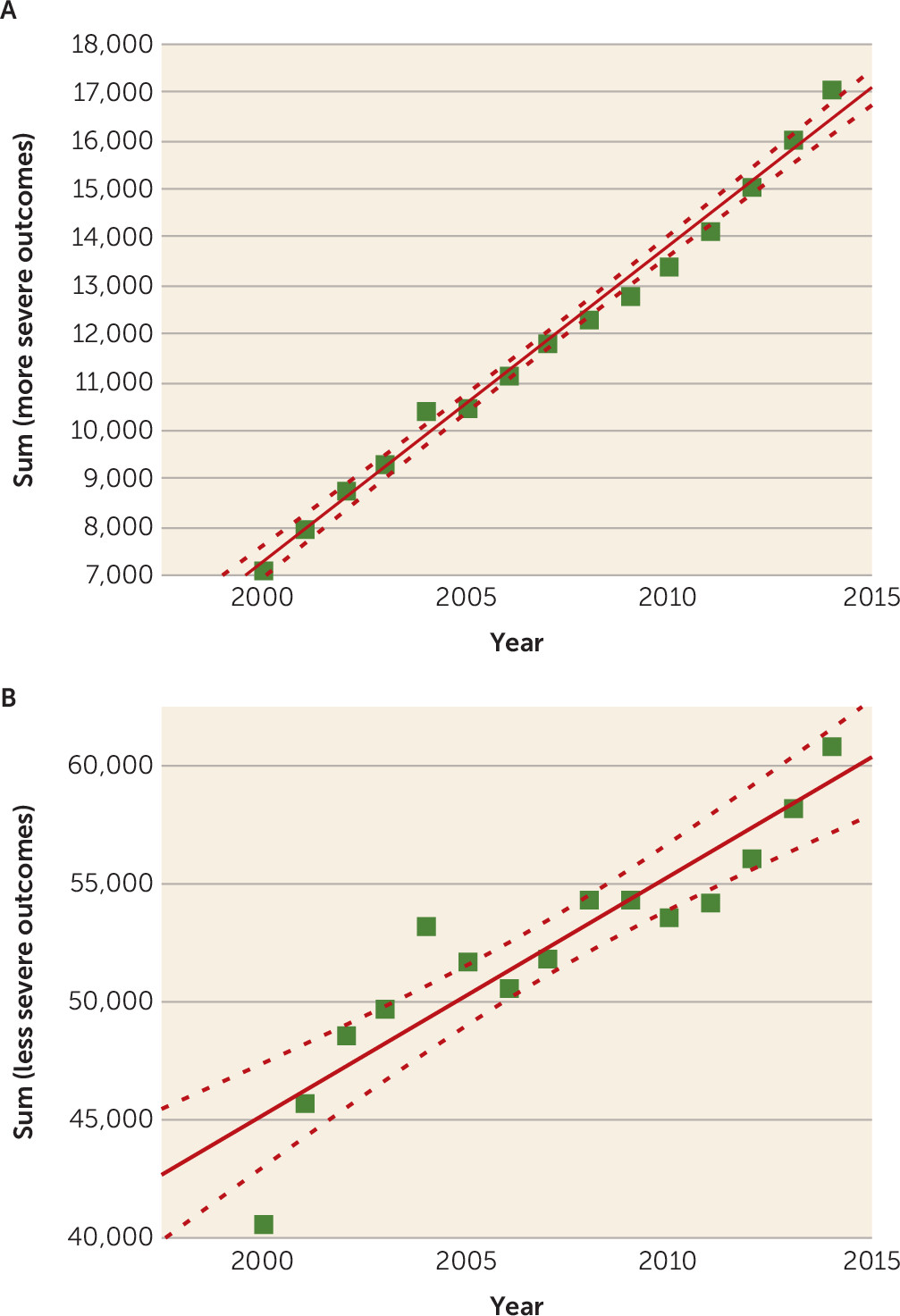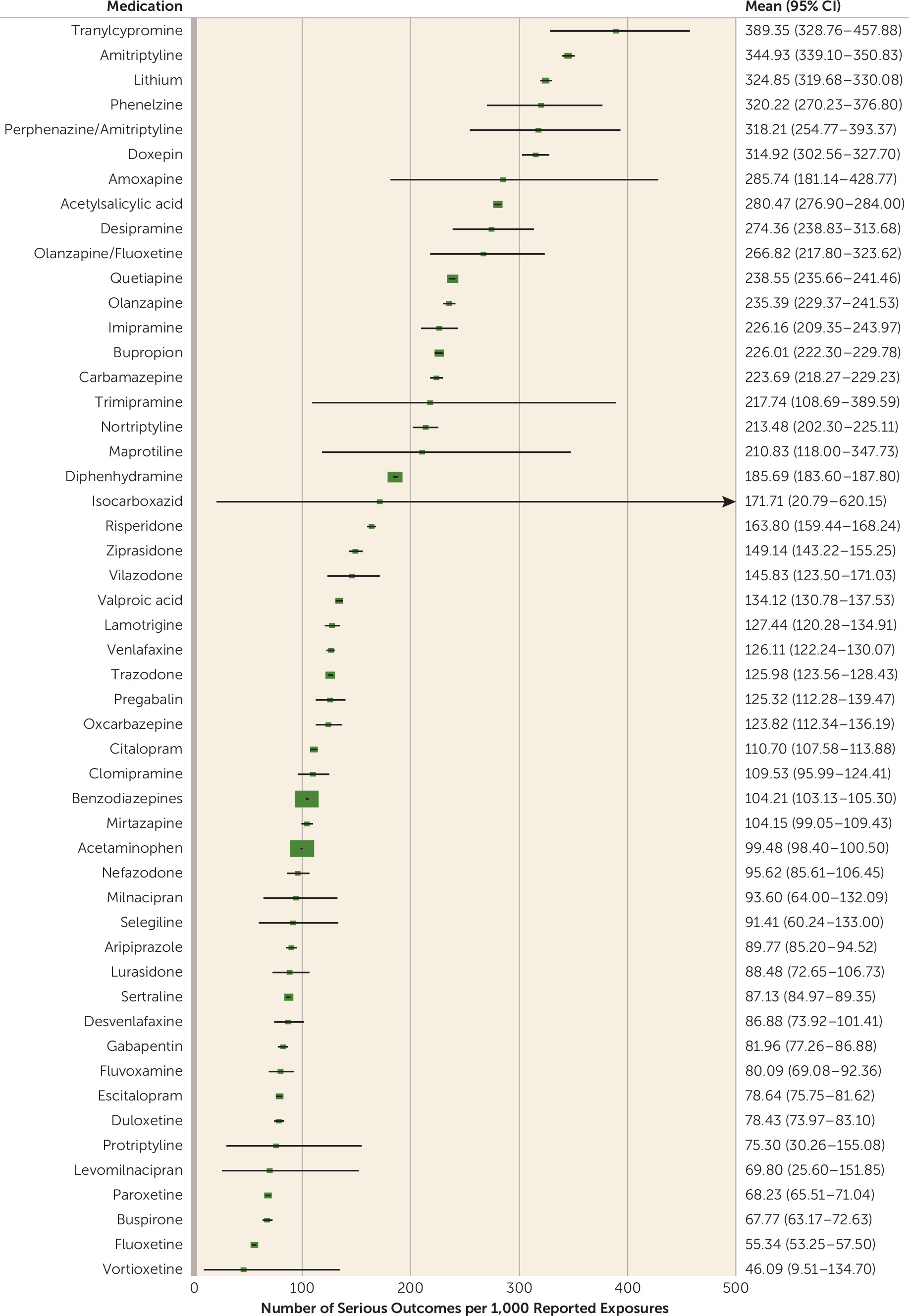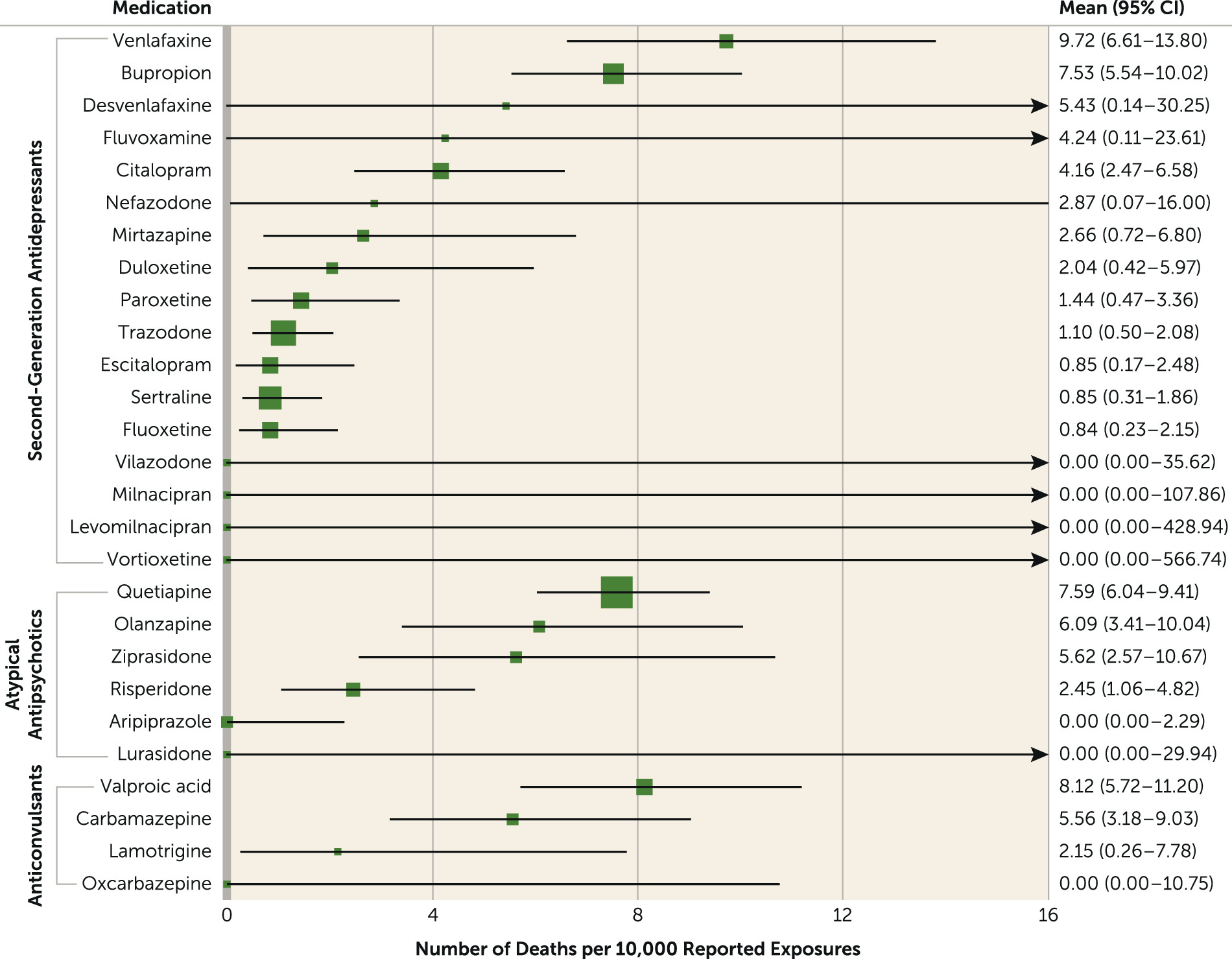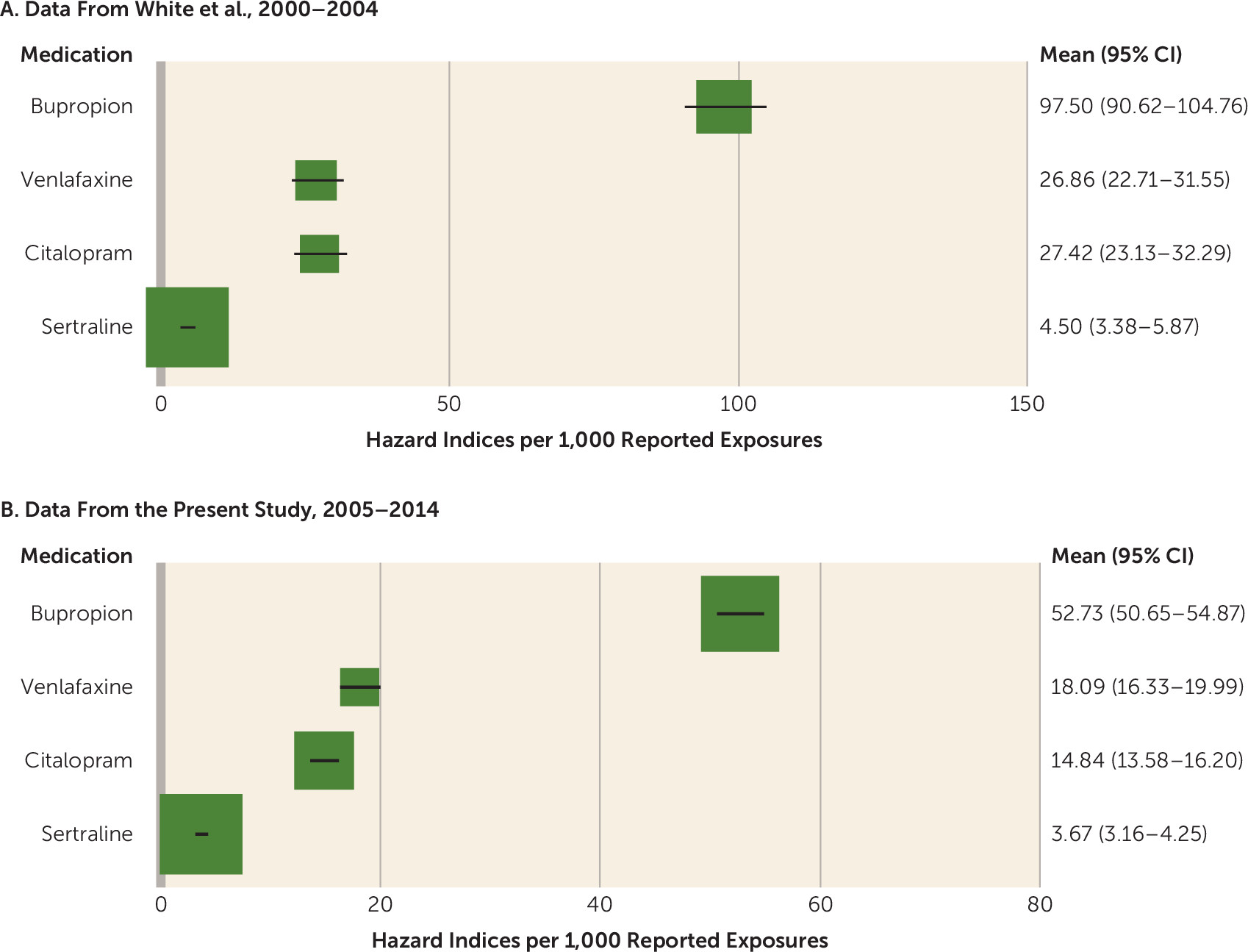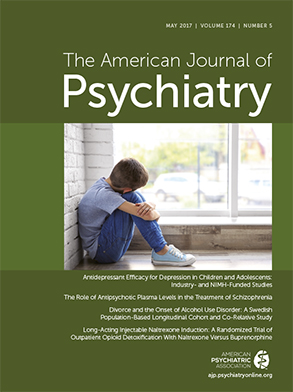Suicide death from drug overdose is a growing problem in the United States. From 2000 through 2014, the suicide rate increased by 25.0% (from 10.4 to 13.0 deaths per 100,000 persons) (
1), and the number of suicides from poisoning increased by 38.5% (
1,
2). Most (89%−92%) of the poisoning deaths involved medications (
2). Depressive disorders (e.g., major depression, dysthymia, and bipolar depression) are significant risk factors for suicide (
3). Unfortunately, the same medications that are given to patients to treat depression can become the vehicle for a serious suicide attempt. Because many suicide attempts are impulsive, readily available medications may be chosen (
4).
Because drugs used to treat depression can be lethal, understanding the relative risk of the various agents used in the treatment of depression seems prudent. The morbidity and lethality of tricyclic antidepressants were recognized soon after their introduction (
5). In 1983 and 1984, tricyclic antidepressants were the leading cause of death by overdose in the United States (
6–
8). When selective serotonin reuptake inhibitors (SSRIs) were introduced, it appeared they were safer in overdose, and deaths associated with SSRIs were often attributed to the ingestion of multiple agents (
9). The apparent safety of SSRIs appeared to contribute to their increased use in the 1990s. Nevertheless, deaths associated with antidepressants are rising, and serious outcomes following ingestion of antidepressants, as reported to the American Association of Poison Control Centers (AAPCC), have been steadily increasing (
10). Thus, even if newer antidepressants are safer than tricyclic antidepressants, the increasing volume of suicide attempts with antidepressants is a significant public health problem and makes differences among these medications important.
Method
The NPDS, which is maintained by the AAPCC (
http://www.aapcc.org) and which contains information logged by regional poison centers serving all 50 United States, Puerto Rico, and the District of Columbia, was queried for single medication exposures during the period 2000–2014. Case records in the NPDS are from self-reported calls; they reflect information provided when the public or health care professionals report an actual or possible exposure to a substance (e.g., an ingestion, inhalation, or topical exposure). Calls received are managed by health care professionals (most commonly registered nurses or pharmacists) who have received specialized training in toxicology. Exposures may involve suspected suicide attempts but also may include other reasons such as unexpected adverse events, therapeutic errors, or other forms of intentional or unintentional misuse. Cases of exposures are followed to determine the outcome, and standard demographic patient information is collected. Information is uploaded from the sites automatically (median time, 8 minutes) making it a unique near-real-time database (
22). For this study, calls requesting information without a suspected medication exposure were not included. Further details about the NPDS can be found elsewhere (
22).
Agents selected for study were antidepressants approved for use in the United States for depression as well as three agents (clomipramine, fluvoxamine, and milnacipran) that are approved in the United States for other indications but may be used off label for depression. Also included were atypical antipsychotic drugs approved for use in unipolar or bipolar depression during this period (aripiprazole, lurasidone, olanzapine, and quetiapine), and risperidone and ziprasidone, whose use is supported by controlled trials and a meta-analysis (
23,
24). Lithium and anticonvulsants (e.g., carbamazepine, lamotrigine, oxcarbazepine, and valproic acid) that are approved for use or commonly used in bipolar disorder were included (
21). Two combination products (perphenazine/amitriptyline and olanzapine/fluoxetine) were included. Finally, a group of agents frequently used to treat anxiety in depression were included: benzodiazepines (as a group), buspirone, pregabalin, and gabapentin. In selecting agents, we elected to be inclusive for agents commonly used in depression rather than limiting selection to medications approved by the Food and Drug Administration (FDA). With these criteria, 46 single medications and two antipsychotic-antidepressant combination products were studied. NPDS cases with related generic category codes (N=50) or product codes (N=4,517) were mapped to the 48 medications studied (see Supplemental Material 1 in the
data supplement that accompanies the online edition of this article). For comparison purposes, three commonly used over-the-counter compounds (acetaminophen, acetylsalicylic acid, and diphenhydramine) were also included.
We completed data extraction on April 30, 2015. At that time, the database for cases in 2014 had not been locked and must be considered provisional; however, 99.96% of the cases for 2014 were closed. (Cases are considered closed when the poison center determines that no further information is available and no further follow-up is required.)
We extracted outcomes data for each reported medication exposure. Only single medication exposures were included to permit attribution of outcomes to specific medications and thus facilitate comparisons of individual drugs. Outcomes are coded as fatal, major, moderate, or less serious (all other outcomes) (
22). Moderate outcomes are characterized by signs and symptoms that result from the exposure and are more pronounced, prolonged, or systemic in nature than minor outcomes but that are not life threatening and do not result in residual disability. Nevertheless, 97% of individuals with moderate outcomes were hospitalized. Major outcomes were associated with life-threatening signs and symptoms or resulted in significant residual disability. Fatal outcomes were cases in which death was the result of the exposure or the result of complications from the exposure. We defined serious exposures as those with a medical outcome classification of fatal, major, or moderate using a definition similar to that used by the AAPCC (
22).
An age threshold was chosen to exclude ingestions in children, which are more frequently accidental. We compared age thresholds at 12, 16, and 20 years with respect to serious outcomes among our 11 drug groups (see Supplemental Material 2 in the
online data supplement). These analyses suggested the use of ≥12 years as the age threshold. This threshold is consistent with NPDS data in which intentional exposures occurred in only 1% of children ≤12 years old but increased to 58% of children 13–19 years of age (
22).
We considered whether to limit the sample to exposures associated with suspected suicide attempts (see Supplemental Material 2 in the data supplement); however, we decided to include exposures for all reasons based on the following considerations: we were interested in the overall morbidity and mortality associated with the therapeutic use of medications in depression; an appreciable number of serious outcomes and fatalities are not related to suicide; a comparison of morbidity indices for the 11 drug groups suggested that the relative morbidity of the groups followed a similar pattern in those with exposures for all reasons and those with suspected suicide; and exclusion of non-suicide-related exposures decreased the sample size by 48% and reduced statistical power especially when examining new individual agents.
The NPDS includes reports of clinical effects associated with each exposure from a standard list of 131 clinical effects. We determined the rate of clinical effects (as a percentage of cases) in exposures resulting in serious outcomes. We excluded 22 clinical effects that are not likely to be related to oral ingestion (e.g., puncture wounds), effects with a frequency of less than 0.05%, and effects categorized as “other.”
Statistical Analysis
We calculated two indices reflecting the severity of the exposure: a morbidity index per 1,000 exposures, and a mortality index per 10,000 exposures, as follows:
We used the term “index” to avoid the implication that we were estimating the actual rate in the population.
We examined the change in the numbers of less serious and serious exposures across 2000–2014 because the AAPCC 2013 annual report (
10) suggested a decline in the reporting of less serious cases for all compounds. We adjusted the number of less serious exposures by applying a correction factor to each year of the less serious exposures to give the same growth profile as serious exposures (see Supplemental Material 3 in the
online data supplement).
Morbidity and mortality indices were determined for each medication. Confidence intervals were determined using Poisson statistics. Forest plots were generated to graphically display differences among the medications. Finally, morbidity indices for three agents identified by White et al. (
20) as more dangerous (bupropion, citalopram, and venlafaxine) during the period 2000–2004 were compared with similar indices in the present data set during the period 2005–2014. For this comparison, we used the “hazard index” (defined as the number of fatal and major outcomes per 1,000 exposures) employed by White et al. (
20). We also included sertraline, the SSRI with the greatest number of exposures, as a comparator.
Data were managed and calculations were performed using SAS JMP version 9.0.0. Stats Direct version 2.8.0 was used to calculate confidence intervals on proportions and to produce forest plots.
Results
During the 15-year study period, there were 962,222 single substance exposures to the 48 medications. Mean age of the cases was 35.8 years; 62.8% were female. Suspected suicide was the reason recorded for 51.4% of all exposures, for 66.9% of exposures with serious outcomes, and for 74.1% of exposures with fatal outcomes. Other reasons for exposures with a frequency ≥1% were therapeutic error (20.4%), unintentional general (6.5%), intentional misuse (5.8%), adverse reaction (5.4%), intentional abuse (3.8%), intentional unknown (3.1%), and unknown reason (1.6%). Oral ingestion of the medications accounted for 98.9% of the exposures. The number of serious outcomes (fatal, major, and moderate) increased 2.26-fold in linear fashion (R
2=0.989, p<0.0001) during the 2000–2014 period (
Figure 1A). The increase in exposures with less serious outcomes was lower, 1.31-fold, and more variable year to year (
Figure 1B). During this period, fatal exposures increased 1.32-fold.
Table 1 presents the number of exposures, the number of exposures by outcome, and the morbidity and mortality indices and includes the three over-the-counter comparator compounds.
Figure 2 provides a graphic display of the morbidity indices and their 95% confidence intervals for the medications.
Figure 3 presents the mortality indices and their confidence intervals for the second-generation antidepressants, antipsychotics, and anticonvulsants. The mortality index for the tricyclic antidepressants, tranylcypromine, and the two combination products are similar to or greater than the mortality indices for acetylsalicylic acid and acetaminophen. Mortality indices for medications in the mildly elevated range (4–6 per 10,000), such as citalopram, desvenlafaxine, carbamazepine, ziprasidone, gabapentin, and olanzapine, are similar to the mortality index for diphenhydramine. The mortality indices for bupropion, quetiapine, venlafaxine, and valproic acid are significantly higher than that for diphenhydramine.
We compared our morbidity data with those reported by White et al. (
20) for the three second-generation antidepressants that those authors found most hazardous (bupropion, citalopram, and venlafaxine) (
Figure 4). We used the same hazard index as White et al. but included all exposures in cases 12 years and older, while White limited exposures to suspected suicides. Sertraline was included as a comparator. As shown in
Figure 4, the morbidity index was greatest for bupropion, followed by venlafaxine and citalopram, and it was lowest for sertraline in both data sets. The mortality indices were also compared (not shown). The order from lowest to highest was the same in each data set: sertraline<citalopram<bupropion<venlafaxine.
Rates of selected clinical effects in individuals with exposures resulting in serious outcomes are shown in
Table 2. Rates of all clinical effects occurring with these medications are shown in Supplemental Material 4 in the
data supplement. The most common clinical events in patients with serious outcomes (frequencies >10%) were drowsiness/lethargy (42.3%), tachycardia (40.7%), hypertension (18.6%), agitation/irritability (17.5%), hypotension (13.4%), confusion (13.2%), tremor (12.4%), and conduction disturbance (10.2%).
Relative to other compounds, tricyclic antidepressants were associated with higher rates of acidosis, cardiac conduction problems, respiratory depression, and seizures. The number of exposures to monoamine oxidase inhibitors (MAOIs) was relatively low, but high rates of hypertension, confusion, increased creatinine, and fever were observed. Relative to other compounds, lithium was associated with higher rates of bradycardia, confusion, and renal problems such as elevated creatinine, oliguria, polyuria, and renal failure.
Bupropion had the highest rate of single and multiple seizures and the highest rate of hallucinations among second-generation antidepressants. Venlafaxine was associated with conduction disturbance, tachycardia, and single seizures, but the rates for these events were not unusually high compared with other medications, and they did not explain the higher mortality index. Citalopram was associated with higher rates of conduction disturbance, seizures (single and multiple), acidosis, and electrolyte disturbances among the SSRIs.
Quetiapine and olanzapine had relatively high rates of coma and respiratory depression relative to other medications. Olanzapine and ziprasidone had relatively elevated rates of conduction disturbance and ECG changes. Valproic acid had relatively high levels of acidosis and coma. As a group, the anticonvulsants had high rates of electrolyte abnormalities, with lamotrigine and oxcarbazepine having the highest. Carbamazepine had high rates of coma and the highest rate of nystagmus of any drug. Lamotrigine had the highest rate (2.1%) of skin rash of any drug.
Among other compounds used to treat anxiety in depression, buspirone had a high rate of bradycardia similar to trazodone, nefazodone, and lithium. Benzodiazepines and pregabalin had moderately high rates of coma and elevated rates of respiratory depression. The morbidity indices for the two combination products, olanzapine/fluoxetine and perphenazine/amitriptyline, were similar to those for olanzapine and amitriptyline, respectively.
Discussion
Over the past 15 years, serious outcomes after exposures to medications used to treat depression increased 2.26-fold. During this period, the population served by poison control centers grew by 18.3%, indicating that the increase in drug poisonings is not explained by population growth. Between 2000 and 2014, serious outcomes (moderate, major, and fatal outcomes) involving human exposures to all compounds in individuals ages 12 and older increased by 69.1% (
22). Our data suggest that serious outcomes associated with exposures to medications used to treat depression are increasing at a rate twice that of exposures to other compounds.
As expected, tricyclic antidepressants and MAOIs have the highest rate of morbidity and mortality among drugs for depression. Amitriptyline accounted for two-thirds of all tricyclic antidepressant exposures and for 145 deaths (or 39.5% of deaths) from all antidepressants. Arguably one of the most important public health implications of our data is that the prescribing of amitriptyline should be reconsidered when safer alternatives are available. Amitriptyline is commonly used off label in the United States for various chronic pain syndromes (
25–
27). Two reports suggest it is often used in patients with relative contraindications (
26,
27). The mortality index for amitriptyline is 18-fold higher than that for duloxetine, which is FDA-approved for use in fibromyalgia, diabetic neuropathic pain, and chronic pain. A recent network meta-analysis found serotonin-norepinephrine reuptake inhibitors (five trials of duloxetine, and two trials of venlafaxine) to be as effective as tricyclic antidepressants for diabetic neuropathic pain (
28). A strong argument could be made for selecting duloxetine rather than amitriptyline for treatment of pain. Doxepin, a tricyclic antidepressant with potent antihistaminic effects, is approved for use for insomnia and for moderate pruritus associated with atopic dermatitis or lichen simplex chronicus. The mortality index for doxepin is even greater than that for amitriptyline.
The morbidity index of clomipramine was lower than that for other tricyclic antidepressants and similar to that of citalopram, benzodiazepines, and mirtazapine, and its mortality index was more similar to second-generation antidepressants than tricyclic antidepressants. These results appear consistent with two reports that compared antidepressant deaths with the number of prescriptions written and that found lower mortality rates for clomipramine than other tricyclic antidepressants (
29,
30). Studies comparing the effects of clomipramine on cardiac conduction appear to be limited in number and to have had mixed findings (
31–
34). Because convincing evidence for cardiac safety is lacking, cardiac monitoring, similar to that for other tricyclic antidepressants, should be performed.
Our results regarding second-generation antidepressants replicate the findings of White et al. (
20). Bupropion has the highest morbidity of this group of agents. Citalopram and venlafaxine have morbidity indices four- to fivefold higher than sertraline. The similarity of the indices for the two data sets over the two periods of 2000–2004 and 2005–2014 also support the reliability of these data. Finally, the comparison of the two sets of findings suggests that the relative morbidity of these agents is similar in exposures for all reasons and in cases of suspected suicide.
In our 2000–2014 data, bupropion and venlafaxine had the highest mortality indices, and they did not differ significantly. Both indices were significantly greater than that for citalopram, which in turn had a significantly higher mortality index than sertraline. Prior reports, based on comparisons with prescriptions written, have suggested there is greater mortality associated with venlafaxine overdose than with SSRIs (
35–
37). Alternatively, Rubino and colleagues (
38) found that venlafaxine was more likely to be used in patients who exhibited factors suggesting greater suicidal risk and that adjusting for those factors reduced mortality risk. The findings of White et al. (
20) indicate that even in patients with a suspected suicide attempt, venlafaxine carries a greater mortality risk. Because of publicity of FDA warnings about dose-dependent conduction delay with citalopram, physicians might anticipate that citalopram would be dangerous in overdose. Our data, however, suggest that bupropion and venlafaxine are more hazardous than citalopram. This hazard has not received commensurate publicity.
Citalopram exposures were about four times as likely to be fatal than sertraline or escitalopram, but the latter two had similar mortality risk. The difference between citalopram and escitalopram in these data suggests the cardiac risks associated with citalopram may not pertain to escitalopram. The mortality index of desvenlafaxine in our data fell between that of citalopram and bupropion; however, the broad confidence interval renders this estimate imprecise. Our data suggest that vilazodone carries greater morbidity risk than that for citalopram or other SSRIs.
We found high morbidity and mortality indices for lithium, consistent with other reports (
20,
39). As expected, lithium was associated with higher rates of adverse renal effects than other medications. Lithium poses a dilemma for clinicians. It is one of the most dangerous drugs in overdose, and it is one of the only drugs that has been shown to reduce suicidality in depressed patients (
40,
41).
Cardiac toxicity after overdose with atypical antipsychotics has been reported in cases and case series. In a systematic review of 102 reports describing 185 adults, Tan et al. (
42) found numerous reports of QT interval prolongation following overdose with atypical antipsychotics but few fatalities. In our data, the mean mortality index for atypical antipsychotics was low: 5.8 deaths per 10,000 exposures (95% CI=4.8–6.9). However, morbidity and mortality varied among atypical antipsychotics. Olanzapine and quetiapine had higher morbidity rates. Olanzapine, quetiapine, and ziprasidone had higher mortality rates than other atypical agents. Cardiac conduction problems were more frequent with olanzapine and ziprasidone. Respiratory depression was more frequent with olanzapine and quetiapine. In a study of fatalities documented in postmarketing safety reports, Marder et al. (
43) found the frequency of respiratory effects was second only to cardiovascular effects for olanzapine. Two other reports found quetiapine to be associated with respiratory depression in severe cases (
44,
45). The following drugs included in this report were associated with at least 200 serious outcomes and with frequencies of respiratory depression >6%: doxepin (13.6%), amitriptyline (12.1%), pregabalin (11.3%), benzodiazepines (11.2%), imipramine (9.0%), quetiapine (8.0%), olanzapine (7.6%), and gabapentin (7.3%). Aripiprazole had low rates of morbidity and mortality more like SSRIs than other atypical antipsychotics. The number of exposures to lurasidone was low, and estimates of the indices were not precise.
Among anticonvulsants, carbamazepine has the highest morbidity index, which was similar to that for olanzapine and quetiapine and twice that for other anticonvulsants. Valproic acid and carbamazepine have moderately high mortality indices, similar to those for olanzapine and quetiapine. The mortality indices for lamotrigine and oxcarbazepine have broad confidence intervals that limit precise estimates.
Clinical effects occurring with overdose can provide important information about potential risks of a medication that are not usually observed with therapeutic dosages. Cardiac events and seizures that occurred with tricyclic drugs are both examples. We learned these effects may become important at usual dosing in individuals who are vulnerable or in conditions in which drug concentrations are elevated (e.g., in poor metabolizers or following drug-drug interactions). In addition, concomitant medications may have additive effects that increase risk. Clinicians may be less familiar with the respiratory depression that can occur with several of the medications used in depression. These effects can be additive and may become clinically relevant in vulnerable persons, such as patients with sleep apnea. For example, Freudenmann et al. (
46) reported two cases of respiratory dysfunction following initiation of quetiapine therapy in patients with sleep apnea.
Our data have both strengths and limitations. Information about exposures to medications is collected systematically by poison centers across the United States and its territories, and the database is large. Unlike data collected in individual clinical centers among patients who seek treatment, the NPDS includes exposures across a range of severity. In addition, there is little reason to expect bias in recording information about the severity of the outcome relative to specific drugs, and thus the data appear useful for comparisons among medications. Our use of age ≥12 years as an inclusion criterion reduces the likelihood of accidental exposures.
There are limitations. Perhaps most importantly, these data were collected via a spontaneous reporting system, and not all drug adverse events or overdoses are reported to poison centers. Thus, NPDS data underestimate the true population rates. We examined single drug exposures to better attribute outcomes to specific medications; however, only about half (48.4%) of exposures to these medications were single drugs. We did not attempt to examine the effect of the amount of drug ingested on outcome. In some cases, the amount is unknown. Often the amount is indirectly estimated (e.g., the number of missing pills). Exposures do not necessarily represent a poisoning or overdose. We elected not to limit exposures to suspected suicide attempts because we sought to assess differences in serious outcomes among the medications regardless of the intent. This method results in a lower morbidity index than if we included only suspected suicides: the pooled morbidity index was 171 for all exposures compared with 222 for suspected suicides in the 12 and older population. However, the corresponding discriminating power among the drugs was 1.4-fold greater (ratio of Cochran’s Q test) for the all-exposure group relative to the suspected-suicide group. Furthermore, we found that the most hazardous second-generation antidepressants were identical to those reported by White et al. (
20), who limited their sample to suspected suicides. In most cases, the poison center does not have direct access to laboratory data to confirm exposure to the reported medication. Thus, the AAPCC is not able to verify the accuracy of reports made to member centers beyond follow-up calls. In some cases, information in the NPDS was unknown. For example, the intent of the exposure was unknown in 1.6% of cases, and in 13.1% of cases the center was unable to follow the case, but the exposure was judged as potentially toxic. Only cases with outcomes clearly documented as moderate, major, or fatal were included as serious outcomes. We excluded antidepressants not approved for any indication in the United States; however, the number of exposures was low: <10 for mianserin, nomifensine, moclobemide, and reboxetine, and 23 exposures for dothiepin.
In summary, serious outcomes, including fatalities, associated with exposures to medications used in the treatment of depression are increasing more rapidly than those for other drugs. The disproportionate increase in serious outcomes with these drugs likely reflects, in part, the administration of these medications to depressed patients who are at increased risk for suicide. As a consequence, clinicians need to be aware of the potential risks when they prescribe antidepressants and other drugs used in the treatment of depression. Although the mortality risks of tricyclic antidepressants appear to be well known, amitriptyline is still widely prescribed and is responsible for more overdose fatalities than any other drug used to treat depression. Our findings indicate substantial differences in morbidity and mortality risks among second-generation antidepressants and other agents currently used in the treatment of depression. Although the risk that an individual depressed patient will overdose and have a serious outcome is quite low, the public health risk is significant given the rising rates of suicide attempts with medications used in depression. In addition, these risks are likely to be magnified in patients with exposure to multiple medications, especially when the other agents have similar clinical effects, such as delayed cardiac conduction, seizures, and respiratory depression. As a consequence, differences among these medications become important. For drugs with similar efficacy and similar mechanisms of action, morbidity and mortality risk following overdose should be an important consideration in drug selection.


